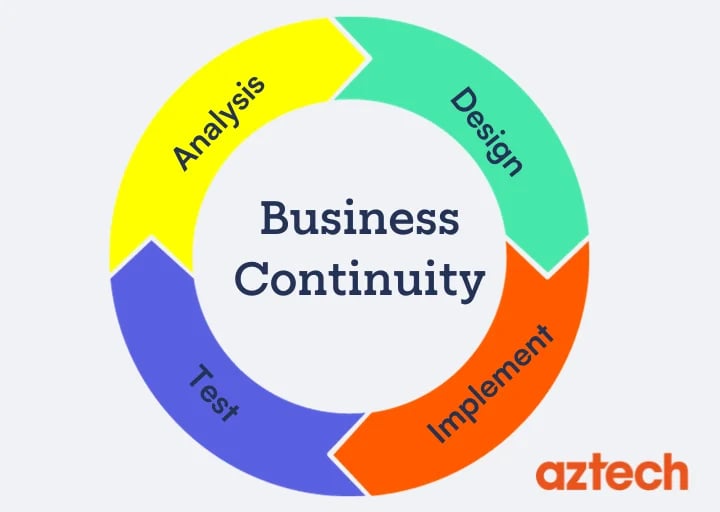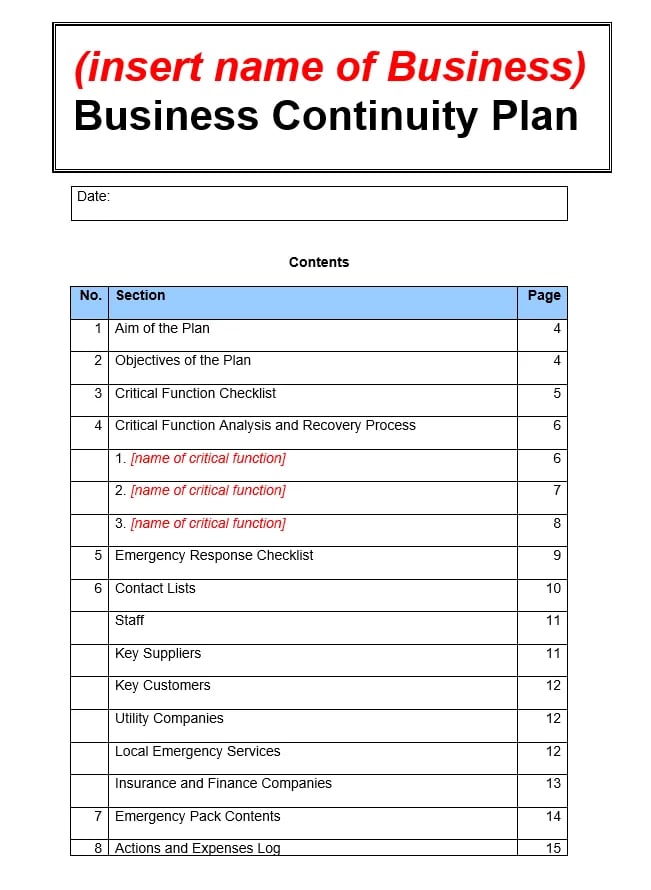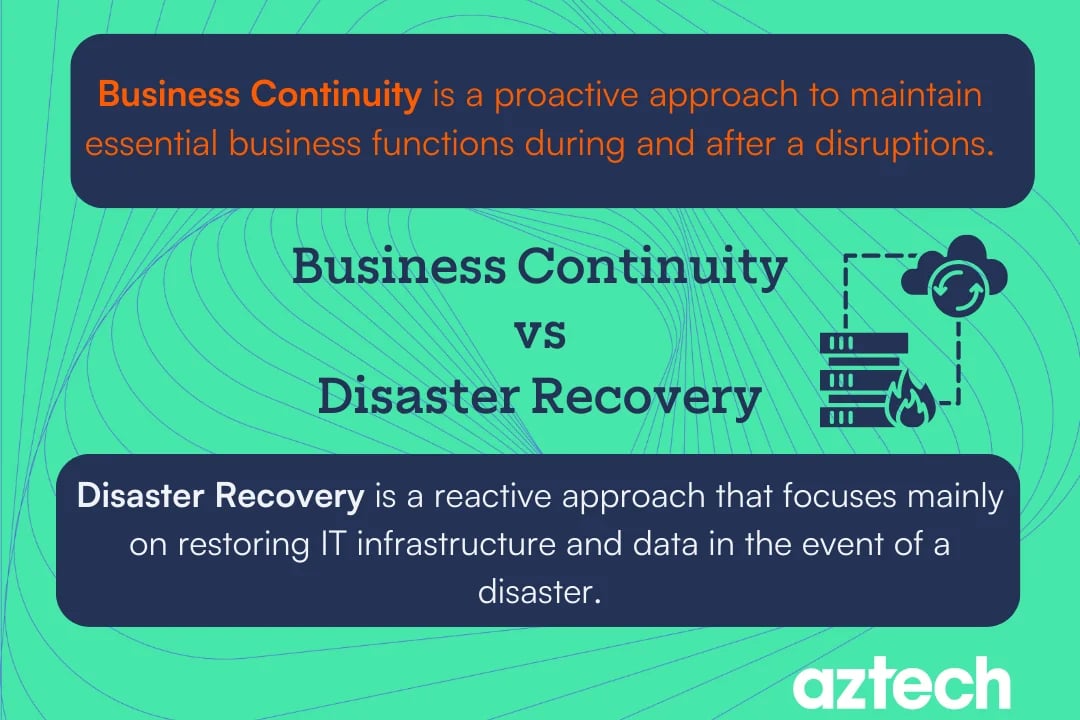Business Continuity Plans (BCPs) are essential documents that provide your organisation with guidance when faced with unexpected outages or disruptions. These plans outline steps to take in order to ensure employees’ safety, while containing potential losses such as data loss or equipment damage.
In this blog post, we will discuss what exactly BCPs are as well as how they can be developed so that you can make sure your organisation is prepared for anything disaster might throw its way.
What is a Business Continuity Plan (BCP)?
A Business Continuity Plan (BCP) is a vital document that outlines a strategy to ensure an organisation can continue to operate during and after a disruptive event, such as a natural disaster, cyber-attack, or pandemic.
A BCP typically outlines key information including emergency contacts and procedures, critical business functions and processes, alternate work locations, data backups, and recovery procedures.

By having a BCP in place, small businesses can minimise the impact of disruptions and ensure the safety of employees and stakeholders. It's important to regularly review and update the BCP to ensure it aligns with current business operations and evolving risks.
Why is Having a Business Continuity Plan (BCP) Important?
In today's fast-paced business world, unexpected events and disruptions can occur at any moment and have severe consequences. This is why having a Business Continuity Plan (BCP) is essential for small businesses to prevent catastrophic losses and keep operations running smoothly during unexpected scenarios.
A BCP is a structured approach which includes a recovery time objective (RTO) and recovery point objective (RPO) to identify potential threats to your key business processes, and it ensures that all essential processes and systems remain operational.
It includes everything from crisis management procedures to protocol for employees' safety, data backup plans, and recovery strategies.
By having a comprehensive BCP in place, companies can minimise downtime, reduce the chances of reputational damage, and quickly recover from any unexpected event.
Benefits of Business Continuity Planning
Here are some key benefits of business continuity planning:
1. Improved Risk Management
Business continuity plans help small businesses to identify and manage potential risks to their business operations. By developing a plan that outlines the steps necessary to respond to various types of disruptions, organisations can better prepare for and mitigate any potential risks.
Additionally, having a plan in place allows organisations to quickly respond to unexpected events, reducing the amount of time it takes to get back up and running.
2. Increased Resilience
Having a business continuity plan also increases an organisation’s resilience in the face of disruption. A well-crafted plan will provide guidance on how to handle different types of disruptions, allowing the organisation to remain operational even when faced with unforeseen circumstances.
This increased resilience can help a small business maintain its competitive edge by ensuring that they are able to continue providing services or products despite any disruption.
3. Reduced Costs
Having a business continuity plan can also help reduce costs associated with human error and disruption. By identifying potential risks and outlining steps for responding to them, small businesses can avoid costly delays or interruptions in their operations due to unexpected events.
Additionally, having a plan in place reduces the need for expensive emergency management response teams, as key staff members are already trained on how to respond in the event of an incident.
4. Improved Compliance
Organisations may also be required by law or industry standards to have some form of BCP in place as part of their compliance requirements.
Having a plan that meets these requirements demonstrates an organisation’s commitment to risk management and helps ensure that they are meeting all relevant regulations and standards related to business continuity planning.
5. Enhanced Reputation
Having a business continuity plan can also help enhance an organisation’s reputation among customers or other stakeholders by demonstrating their commitment to preparedness and reliability if disaster strikes.
Customers may be more likely to trust an organisation if they know that it has taken proactive steps such as developing a BCP in order to protect itself from potential disruptions or threats.
6. Improved Employee Morale
Finally, having a business continuity plan can improve employee morale by providing employees with peace of mind that their employer is taking measures necessary for protecting them if disaster strikes.
Knowing that their employer is taking steps such as developing a comprehensive BCP can make employees feel safer and more secure which may leave them feeling more engaged and motivated in a work environment.
Elements of BCP (Examples)
1. Risk Assessment
A key component of any business continuity planning is a risk assessment. This is the process of identifying potential risks that could affect the organisation and assessing their likelihood and potential impact.
The risk assessment should include both internal and external risks, such as natural disasters, cyber-attacks, or supply chain disruptions.
Once the risks have been identified, the organisation can begin to develop strategies to mitigate them.
2. Data Backup and Disaster Recovery Planning
Data backup and disaster recovery planning are essential for any business continuity planning. These plans ensure that critical data is backed up regularly and can be quickly recovered in the event of an emergency or disaster.
The plan should include details on how data will be backed up, where backups will be stored, and how they will be accessed in an emergency situation.
3. Business Impact Analysis
A business impact analysis (BIA) is a tool used to identify which business processes or systems are most critical to the organisation’s operations.
It considers factors such as financial losses, customer satisfaction, legal liability, and organisational reputation when determining which processes or systems should be prioritised for protection in a disaster scenario.
4. Communication Plan
Communication plans are also important components of any business continuity planning. The communication plan outlines how information will be shared with employees, customers, vendors, suppliers, partners, etc., during an emergency or crisis situation.
It should include details on who will receive what type of information and when they will receive it so that everyone is aware of what is happening and can respond appropriately.
How to Create an Effective Business Continuity Plan
Here are 9 steps to create an effective BCP:
Step 1: Identify Critical Functions
The first step in creating a business continuity plan is to identify the critical business functions that need to be maintained during an emergency or major disruption.
This includes identifying which business processes, systems, and personnel are essential for the continued functioning of the organisation.
It is important to ensure that all key stakeholders are involved in this process, as their input will help to ensure that all key functions are identified.
Step 2: Assess Risks
Once the critical functions have been identified, it is important to assess the possible risks associated with them.
This includes analysing potential threats such as natural disasters, cyberattacks, and supply chain disruptions.
It is also important to assess how likely new risks are to occur and what its potential impact on the organisation would be if it did occur.
Step 3: Develop Strategies
Once the risks have been assessed, it is time to develop strategies for mitigating them. This may include developing backup plans for critical systems or personnel, implementing procedures for responding quickly and effectively in the event of an emergency or disruption, and establishing protocols for communicating with stakeholders during a crisis situation.
Step 4: Create Disaster Recovery Plan
A disaster recovery plan outlines specific steps that should be taken in order to restore operations following an emergency or disruption.
The disaster recovery plans should include detailed instructions on how to respond to various types of incidents as well as contact information for key personnel who can help during an emergency situation.
Step 5: Establish Testing Procedures
It is important to establish business continuity testing procedures in order to ensure that your business continuity plans work as intended when needed.
Testing can involve simulating various scenarios in order to evaluate how well different components of the plan work together and whether any changes need to be made prior to implementation.
Step 6: Train Employees
In order for a business continuity plan to be effective, employees must understand their roles and responsibilities before, during, and after an emergency or disruption occurs.
Training sessions should be conducted regularly so that employees are familiar with their duties under different circumstances and know what steps they need take when responding to an incident.
Step 7: Document Plan
Once all of these steps have been completed, it is important that everything is documented properly so that it can easily be accessed by those who need it when necessary.
This includes recording contact information for key personnel as well as detailing each step of the response process so that everyone knows exactly what needs to be done in order to maintain operations during an emergency situation or disruption.
Step 8: Review & Update Plan
It is important that your business continuity plan remains up to date with changing technologies and regulations so that it remains effective over time.
Therefore, you should review your plan at least once per year (or more often if necessary) and make any necessary updates.
Additionally, any changes made within your organisation should also be reflected in your business continuity planning.
Step 9: Monitor Performance
Monitoring performance allows you to identify areas where improvements can be made in order to increase efficiency.
This could involve tracking response times, reviewing customer feedback, or assessing how well different components of your business continuity plan work together.
By monitoring performance, you can make sure your organisation remains prepared for any type of incident or disruption.
Business Continuity Management
Business continuity management is the process of ensuring that a company's critical functions and operations continue to operate uninterrupted in the face of unforeseen disruptions.
This involves creating plans and strategies that allow businesses to respond swiftly and effectively to any crises or disasters with a crisis management communication.
In addition, an effective business continuity management team is critical to a company's success, as the ability to quickly recover from unexpected disruptions can mean the difference between success and failure.
By implementing a strong business continuity plan, companies can ensure that they are able to quickly return to full function after any business disruption, minimising the impact on clients, employees, and customers alike.
Business Continuity Planning Standards
The ISO 22301:2019 standard, developed by the International Organisation for Standardisation (ISO), is recognised worldwide as the benchmark for business continuity management. This standard is often complemented by other relevant standards, including:
- ISO 22313: Guidance on the use of ISO 22301
- ISO 22317: Guidelines for business impact analysis
- ISO 22318: Continuity of supply chains
- ISO 22398: Exercise guidelines
- ISO 22399: Incident preparedness and operational continuity management
Additionally, there are other notable standards in this field, such as:
- National Fire Protection Association (NFPA) 1600: Emergency management and business continuity
- National Institute of Standards and Technology (NIST) SP 800-34: IT contingency planning
- British Standards Institution (BSI) BS 25999: Standard for business continuity
Business Continuity Plan Template for Small Business UK
A business continuity plan template is a document that outlines the strategies and procedures, your small business will use to continue operating during and after a disruption. This business disruption can be caused by natural disasters, power outages, cyber-attacks, or other unforeseen events.
A comprehensive BCP template will help you identify potential risks and develop proactive solutions to mitigate these risks.
In other words, a BCP template will help ensure that your business is prepared for any unexpected event that could potentially impact your operations, thus ensuring your business's survival in the long run.
 Source: Hertfordshire County Council
Source: Hertfordshire County Council
BCP templates consist of:
- Aim of the Plan
- Objective of the Plan
- Critical Function Checklist
- Critical Function analysis and business recovery process
- Emergency response checklist
- Contact lists
- Key Staff
- Key Suppliers
- Key Customers
- Utility Companies
- Local Emergency Services
- Insurance and Finance Companies
- Emergency Pack Contents
- Action and Expenses log
You can download the UK business continuity plan template here.
Business Continuity vs Disaster Recovery

When it comes to preparing for potential disruptions in day-to-day operations, two concepts often come up: business continuity and disaster recovery plans. While they share some similarities, they are not interchangeable terms.
Business continuity is a proactive and holistic approach to maintaining essential business functions during and after a disruption. It involves thinking through all aspects of the business, identifying potential risks and vulnerabilities, and putting plans in place to manage them.
Conversely, disaster recovery is a reactive approach that focuses primarily on restoring IT infrastructure and data in the event of a disaster or system failure.
In short, business continuity is about keeping the business running, while disaster recovery is about recovering from a particular event.
Business Continuity Planning FAQs
What are the 5 components of a business continuity plan?
A business continuity plan consists of five key components: risk assessment, business impact analysis, strategies and solutions, plan development, and plan testing and maintenance.
What are the 5 steps of a business continuity plan?
The Business continuity plan consists of five essential steps that a business must take to ensure its survival during such crises. First off, the plan must identify potential risks and their impact on the business. Second, it should establish communication protocols, so employees can be informed and kept safe. The third step involves having a comprehensive plan in place, which should include a recovery strategy. Fourth, it is important to test the plan regularly to ensure it is effective. Lastly, the continuity plan should be reviewed and updated regularly to accommodate any changes that might occur.
What are the 4 P’s of business continuity?
The 4P’s of business continuity includes people, processes, premises, and providers with additional 3 P’s which are preparedness, protection, and performance.
What should be in a business continuity plan?
There are several key elements that should be in a business continuity plan, including a clear explanation of the essential business functions, risk assessments, recovery strategies, communication protocols, and roles and responsibilities of team members.

-1.png?width=552&height=678&name=text-image%20module%20desktop%20(4)-1.png)


.png?width=2000&name=Case%20study%20(21).png)


-2.png?width=422&height=591&name=text%20image%20tablet%20(31)-2.png)






